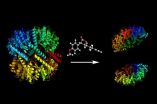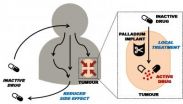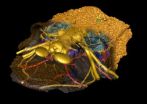(Press-News.org) This news release is available in German.
Proteins are made up of a chain of amino acids and are vital for all cell processes. Proteases are among the most important types of protein. Like "molecular scissors", they cut other proteins at given positions and thereby execute important cell functions. By cutting the amino acid chains to the right length or breaking proteins apart they, for example, activate or deactivate proteins, decompose defective ones or switch signal sequences that serve to transport proteins to their proper position within a cell.
But proteases are important not only for human cells – bacteria also rely on them. There are hardly any effective antibiotics left in the fight against pathogens like multi-resistant strains of Staphylococcus aureus bacteria or Mycobacterium tuberculosis which causes tuberculosis.
Researchers around the world are thus working ardently to find new ways of disarming the proteases in these strains to combat them. At the heart of this effort lies the so-called ClpP protease. It comprises 14 subunits and has a central regulatory function. The usual approach to deactivating this protease is to block all active centers of the ClpP. These are effectively the "cutting edges of the scissors", i.e. the portions of the protein that are responsible for breaking apart other proteins.
"However, the inhibitors used in the past have one decisive disadvantage," explains Stephan Sieber who heads the Chair for Organic Chemistry II at the Technische Universitaet Muenchen (TUM). "They don't permanently disarm the proteins, but only work for a few hours. On top of that, to be effective they must attack all active centers of the protein."
New strategies against bacteria
In collaboration with Professor Michael Groll, who heads the Chair for Biochemistry, Malte Gersch and Roman Kolb, doctoral candidates at Professor Sieber's chair, have succeeded in uncovering two completely new mechanisms that can be used to permanently deactivate these important bacteriological proteases – in one case even without having to attack all active centers of the protein.
The first mechanism disrupts the arrangement of amino acids required for the cohesion of the protease subunits. As a result the protease breaks into two parts. The second acts directly on the core of the active center. It converts the amino acid that does the actual splitting into another kind of amino acid – the "scissors" lose their edge and the protein is rendered inoperable. Both approaches inhibit the protease in completely novel ways and are thus very promising for the development of new forms of medication.
The scientists also found a whole series of inhibitors that initiate the two mechanisms. "Knowing the ways in which substances deactivate the proteases is a huge advance," says Gersch. "We can now optimize the substances and possibly also apply the principle to other proteases."
In further research, Gersch and Sieber plan to test their substances on living bacterial strains to determine if these are truly inhibited in growth and pathogenic effect. "Although the bacteria are not completely disarmed, they produce significantly fewer toxins that are conducive to inflammation," says Gersch. "The basic idea is that we give the immune system more time to handle the pathogens on its own while the formation of new resistances is suppressed."
INFORMATION:
The research was funded by the Deutsche Forschungsgemeinschaft (DFG; SFB 749 and SFB 1035, Cluster of Excellence Center for Integrated Protein Research Munich (CIPSM)), by the European Research Council (ERC starting grant), The Fund of the Chemical Industry and the German National Academic Foundation. The crystal structures were determined in collaboration with the synchrotron radiation source of the Paul Scherrer Institute in Villigen (Switzerland).
Publication:
Malte Gersch, Roman Kolb, Ferdinand Alte, Michael Groll, Stephan Sieber. Disruption of Oligomerization and Dehydroalanine Formation as Mechanisms for ClpP Protease Inhibition. Journal of the American Chemical Society (JACS), 2014, 136 (4), pp 1360-1366.
DOI: 10.1021/ja4082793 – Abstract: http://pubs.acs.org/doi/abs/10.1021/ja4082793
Two new weapons in the battle against bacteria
New mechanisms of action open alternative approaches to antibiotics development
2014-02-13
ELSE PRESS RELEASES FROM THIS DATE:
Metal implants may cut chemotherapy side effects, study suggests
2014-02-13
Cancer patients could one day experience fewer side effects from chemotherapy following a discovery that opens the door for more targeted treatments.
Researchers have identified a possible way of treating tumours that would see doctors place harmless metal implants at the cancer site.
The discovery could make treatment more targeted than existing therapies, avoiding unwanted side effects, such as hair loss, tiredness and nausea. These occur when chemotherapy drugs carried in the blood kill healthy cells as well as cancer cells.
The scientists found that they could ...
Deutsche eMark (DEM) - Could be second cryptocurrency coin after Bitcoin
2014-02-13
Deutsche eMark is an open source peer-to-peer digital Internet currency. Deutsche eMark stands for fast and secure payments to anyone around the world, who has an eMark Wallet. Therefore no banks are required and the fees are low and simple to understand. Today price on Cryptsy Exchange is 0.00012, but experts says, that it could fast reach 0.002 DEM/BTC.
Sleep apnea common among stroke-related brainstem injuries
2014-02-13
People whose brainstems are affected by their stroke have a significantly higher prevalence of sleep apnea than those who have stroke-related injury elsewhere in the brain, according to research presented at the American Stroke Association's International Stroke Conference 2014.
Sleep apnea is marked by interrupted breathing during sleep and can lead to serious health problems including heart disease and stroke.
"This is the largest population-based study to address the issue of the location of the brain injury and its relationship to sleep apnea in post-stroke patients," ...
ADHD drugs not linked to increased stroke risk among children
2014-02-13
Children who take medication to treat attention deficit hyperactivity disorder (ADHD) don't appear to be at increased stroke risk, according to a study presented at the American Stroke Association's International Stroke Conference 2014.
In a study of 2.5 million 2- to 19-year-olds over a 14-year period, researchers compared stimulant medication usage in children diagnosed with ischemic or hemorrhagic stroke to stimulant usage in children without stroke.
Researchers found no association between stroke risk and the use of ADHD stimulant medications at the time of stroke ...
Worm infections in developing countries: Veterinary drugs improve the health of school children
2014-02-13
This news release is available in German.
Hookworms and whipworms are detrimental to health. Children in many developing countries in particular are prone to regular infection via contaminated soil due to a lack of latrines and clean water. Whipworm eggs enter the body via the gastrointestinal tract and evolve over several devel-opment stages. To contain the health risks of worm infections, the WHO recommends annual de-worm treatment for children and at-risk groups (such as field hands and miners). However, the recommended standard treatment appears to have little ...
New research uncovers debilitating effects of disease on toy dog breeds
2014-02-13
A new study from the University of Surrey, published today in the journal PLOS One, has identified the specific effect Chiari malformation has on the shape of a dog's skull and brain. This condition has become prevalent as a result of selective breeding and affects many toy dog breeds which have been bred to look more doll-like, including Griffon Bruxellois, Cavalier King Charles Spaniels, Chihuahuas and their crosses.
Researchers took brain, skull and vertebrae measurements of 155 Griffon Bruxellois and compared dogs affected by the condition, with normal Griffons. ...
Jawed vertebrates get a face
2014-02-13
This week in the leading journal Nature, a team of French and Swedish researchers present new fossil evidence for the origin of one of the most important and emotionally significant parts of our anatomy: the face. They show how a series of fossils, with a 410 million year old armoured fish called Romundina at its centre, documents the step-by-step assembly of the face during the evolutionary transition from jawless to jawed vertebrates.
Vertebrates (backboned animals) come in two basic models: jawless and jawed. Today, the only jawless vertebrates are lampreys and hagfishes, ...
Quality of acupuncture needles is less than perfect and must improve
2014-02-13
The quality of acupuncture needles is high, but should still be universally improved to avoid potential problems, such as pain and skin reactions, finds research published online in Acupuncture in Medicine (AiM).
Despite improvements to the manufacturing process, surface irregularities and bent tips have not been completely eliminated, say the researchers.
In China, traditional Chinese medicine including acupuncture, accounts for 40% of all medical treatment, while in the West, acupuncture is one of the most frequently used complementary therapies.
An estimated 1.4 ...
Tobacco industry claims 'plain' packs won't work based on weak evidence
2014-02-13
Tobacco companies lack strong, relevant evidence to support their claims that standardised (plain) packaging of tobacco products in the UK won't work, finds research published in the online journal BMJ Open.
The aim of plain packaging, with no logos, brand imagery, symbols, or promotional text, is to restrict the already limited opportunities that transnational tobacco companies have to market their products, and deter people from starting smoking.
Australia adopted plain packaging for tobacco products in 2012, the same year that the Department of Health in England ...
Hospitals not always prepared for full costs of implementing electronic patient records
2014-02-13
Hospitals don't always take into account the full costs of implementing new electronic health record systems and should be better prepared if they are to maximise the benefits, finds research published online in the Journal of the American Medical Informatics Association (JAMIA).
Electronic health record (EHR) systems can improve the safety, quality, and efficiency of healthcare in hospitals, and their adoption is a priority for the UK and US governments.
But despite their promise and the existence of EHRs in UK primary care for several decades, UK hospitals have been ...
LAST 30 PRESS RELEASES:
Human adipose tissue: a new source for functional organoids
Metro lines double as freight highways during off-peak hours, Beijing study shows
Biomedical functions and applications of nanomaterials in tumor diagnosis and treatment: perspectives from ophthalmic oncology
3D imaging unveils how passivation improves perovskite solar cell performance
Enriching framework Al sites in 8-membered rings of Cu-SSZ-39 zeolite to enhance low-temperature ammonia selective catalytic reduction performance
AI-powered RNA drug development: a new frontier in therapeutics
Decoupling the HOR enhancement on PtRu: Dynamically matching interfacial water to reaction coordinates
Sulfur isn’t poisonous when it synergistically acts with phosphine in olefins hydroformylation
URI researchers uncover molecular mechanisms behind speciation in corals
Chitin based carbon aerogel offers a cleaner way to store thermal energy
Tracing hidden sources of nitrate pollution in rapidly changing rural urban landscapes
Viruses on plastic pollution may quietly accelerate the spread of antibiotic resistance
Three UH Rainbow Babies & Children’s faculty elected to prestigious American Pediatric Society
Tunnel resilience models unveiled to aid post-earthquake recovery
Satellite communication systems: the future of 5G/6G connectivity
Space computing power networks: a new frontier for satellite technologies
Experiments advance potential of protein that makes hydrogen sulfide as a therapeutic target for Alzheimer’s disease
Examining private equity’s role in fertility care
Current Molecular Pharmacology achieves a landmark: real-time CiteScore advances to 7.2
Skeletal muscle epigenetic clocks developed using postmortem tissue from an Asian population
Estimating unemployment rates with social media data
Climate policies can backfire by eroding “green” values, study finds
Too much screen time too soon? A*STAR study links infant screen exposure to brain changes and teen anxiety
Global psychiatry mourns Professor Dan Stein, visionary who transformed mental health science across Africa and beyond
KIST develops eco-friendly palladium recovery technology to safeguard resource security
Statins significantly reduce mortality risk for adults with diabetes, regardless of cardiovascular risk
Brain immune cells may drive more damage in females than males with Alzheimer’s
Evidence-based recommendations empower clinicians to manage epilepsy in pregnancy
Fungus turns bark beetles’ defenses against them
There are new antivirals being tested for herpesviruses. Scientists now know how they work
[Press-News.org] Two new weapons in the battle against bacteriaNew mechanisms of action open alternative approaches to antibiotics development




